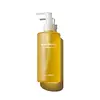What's inside
What's inside
 Key Ingredients
Key Ingredients

 Benefits
Benefits

 Concerns
Concerns

 Ingredients Side-by-side
Ingredients Side-by-side

Oryza Sativa Bran Oil 41.94%
EmollientVitis Vinifera Seed Oil
EmollientGlycine Soja Oil
EmollientSorbeth-30 Tetraoleate
EmulsifyingSimmondsia Chinensis Seed Oil
EmollientHelianthus Annuus Seed Oil
EmollientPrunus Amygdalus Dulcis Oil
Skin ConditioningCamellia Sinensis Seed Oil
HumectantBisabolol
MaskingWater
Skin ConditioningPyrus Malus Fruit Extract
Skin ConditioningTheobroma Cacao Extract
Skin ConditioningVanilla Planifolia Fruit Extract
Skin ConditioningFragaria Chiloensis Fruit Extract
Skin ConditioningPrunus Persica Fruit Extract
AbrasiveMusa Sapientum Fruit Extract
Skin ConditioningCocos Nucifera Oil
MaskingPrunus Domestica Fruit Extract
MoisturisingOryza Sativa Bran Oil 41.94%, Vitis Vinifera Seed Oil, Glycine Soja Oil, Sorbeth-30 Tetraoleate, Simmondsia Chinensis Seed Oil, Helianthus Annuus Seed Oil, Prunus Amygdalus Dulcis Oil, Camellia Sinensis Seed Oil, Bisabolol, Water, Pyrus Malus Fruit Extract, Theobroma Cacao Extract, Vanilla Planifolia Fruit Extract, Fragaria Chiloensis Fruit Extract, Prunus Persica Fruit Extract, Musa Sapientum Fruit Extract, Cocos Nucifera Oil, Prunus Domestica Fruit Extract
Glycine Soja Oil 50%
EmollientSorbeth-30 Tetraoleate
EmulsifyingCetyl Ethylhexanoate
EmollientEthylhexyl Palmitate
EmollientParfum
MaskingEthylhexylglycerin
Skin ConditioningWater
Skin ConditioningGlycerin
HumectantBifida Ferment Lysate
Skin Conditioning1,2-Hexanediol
Skin ConditioningSimmondsia Chinensis Seed Oil
EmollientOryza Sativa Bran Oil
EmollientCaprylic/Capric Triglyceride
MaskingCamellia Sinensis Seed Oil
HumectantButylene Glycol
HumectantHoney Extract
HumectantRoyal Jelly Extract
Skin ConditioningPropolis Extract
Skin ConditioningGlycine Soja Oil 50%, Sorbeth-30 Tetraoleate, Cetyl Ethylhexanoate, Ethylhexyl Palmitate, Parfum, Ethylhexylglycerin, Water, Glycerin, Bifida Ferment Lysate, 1,2-Hexanediol, Simmondsia Chinensis Seed Oil, Oryza Sativa Bran Oil, Caprylic/Capric Triglyceride, Camellia Sinensis Seed Oil, Butylene Glycol, Honey Extract, Royal Jelly Extract, Propolis Extract
Ingredients Explained
These ingredients are found in both products.
Ingredients higher up in an ingredient list are typically present in a larger amount.
Camellia Sinensis Seed Oil is the oil expressed from the seeds from the tea plant. This is the same plant we get green, black, and oolong tea from.
Camellia Sinensis Seed Oil is rich in oleic acid. This makes it an effective moisturizer. By drawing moisture to the skin, Camellia Oleifera Seed Oil helps keep your skin hydrated.
Other components of Camellia Sinensis Seed Oil includes Vitamin E and polyphenols. These are antioxidants that may help slow down the signs of aging. Antioxidants help fight free-radicals, or unstable molecules that can damage our skin cells.
Camellia Sinensis Seed Oil also has anti-inflammatory properties.
The seed oil comes from the dried kernels of the plant.
Learn more about Camellia Sinensis Seed OilGlycine Soja Oil comes from the soybean. Glycine Soja is native to eastern Asia.
Soybean oil is an emollient. It is rich in antioxidants and fatty acids including palmitic, stearic, oleic, and linoleic acids.
As an emollient, the fatty acids in soybean oil helps keep your skin soft and hydrated. It does so by creating a film on top that traps moisture in.
Soybean oil is also rich in vitamin E, a potent antioxidant. Vitamin E is also anti-inflammatory and provides a soothing effect.
Studies show soy may help fade hyperpigmentation from UVB. It does so by disrupting the melanin process from UVB induced skin inflammation.
This ingredient may not be malassezia folliculitis, or fungal-acne, safe.
Soybeans are rich in proteins and are part of the legume family. Foods made with soybeans include tofu, soymilk, edamame, miso, and soy sauce.
Learn more about Glycine Soja OilOryza Sativa Bran Oil comes from the outer layer of a rice kernel. It is a byproduct of milling rice, or the operation to produce a whole grain rice product.
This ingredient has emollient and skin conditioning properties. This is due to its polysaccharides and omega-3 fatty acids.
Emollients help soothe and soften the skin. It does this by creating a protective film on your skin. This barrier helps trap moisture and keeps your skin hydrated.
Learn more about Oryza Sativa Bran OilThis oil comes from the seeds of the desert shrub called Jojoba. It is more commonly known as jojoba oil, a non-comedogenic oil.
Jojoba oil does not contain fragrance and has many fatty-acids, making it a great soothing ingredient.
It also contains Vitamin E, a great moisturizing ingredient. Vitamin E is also an antioxidant and protects your skin against oxidative damage.
This ingredient humectant properties, meaning it helps draw moisture from the air. This helps keep your skin hydrated.
While jojoba has antibacterial properties, it is only able to kill some strains of bacteria.
Studies also show it helps in wound healing. In fact, Indigenous cultures have used jojoba as a moisturizer and to help treat burns for centuries.
Fun fact: Jojoba oil similar to natural human skin sebum, so it has a great effect on dry skin. It is also promising with helping to regulate sebum production.
Due to its fatty acid content, Jojoba oil may not be fungal acne safe. We recommend speaking with a professional if you have any concerns.
Learn more about Simmondsia Chinensis Seed OilSorbeth-30 Tetraoleate is a surfactant and emulsifier.
This ingredient is a tetraester from oleic acid and polyethylene glycol ether of sorbitol.
As an emulsifier, it helps ingredients such as oil and water mix together. This allows the dirt and oils in your skin to be washed away.
One study found pumpkin oil containing Sorbeth-30 Tetraoleate helped hydrate the skin and did not cause any irritation.
Learn more about Sorbeth-30 TetraoleateWater. It's the most common cosmetic ingredient of all. You'll usually see it at the top of ingredient lists, meaning that it makes up the largest part of the product.
So why is it so popular? Water most often acts as a solvent - this means that it helps dissolve other ingredients into the formulation.
You'll also recognize water as that liquid we all need to stay alive. If you see this, drink a glass of water. Stay hydrated!
Learn more about Water